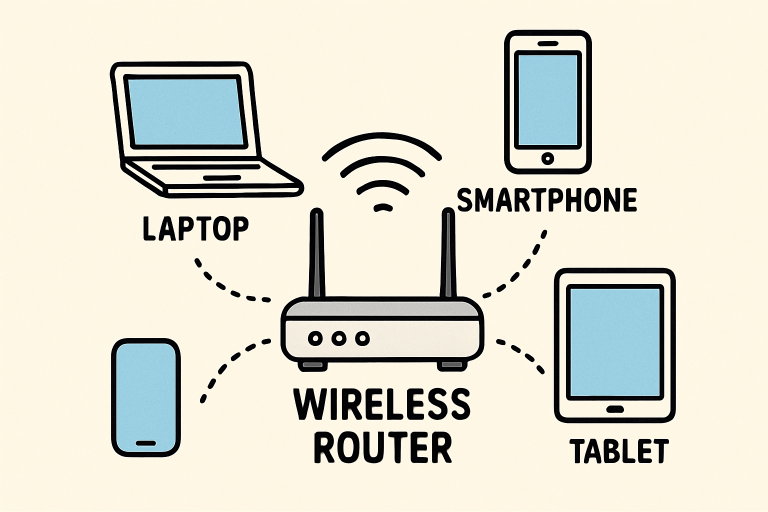Key Takeaways
- Wireless networks drive flexibility, scalability, and business growth.
- Cost savings, enhanced collaboration, and robust security are core benefits.
- Modern wireless solutions are essential for future-proofing operations and adopting new technologies.
Table of Contents
- Enhanced Mobility and Flexibility
- Cost-Effective Implementation
- Scalability to Support Growth
- Improved Collaboration Among Teams
- Enhanced Security Measures
- Support for IoT and Smart Devices
- Business Continuity and Reliability
- Future-Proofing with Advanced Technologies
- Conclusion
In an era where connectivity is not just a convenience but a business imperative, wireless network solutions are redefining how companies operate and compete. The drive toward digital transformation means organizations must be agile and prepared to adapt to rapidly changing business demands. Whether enabling remote work, facilitating a hybrid workforce, or integrating new technologies, modern wireless systems provide the backbone for a truly connected and efficient workplace. Businesses seeking wireless network solutions in San Francisco are uniquely positioned to leverage these benefits, especially in bustling metropolitan environments where competition and innovation are constant.
Wireless networking is essential in today’s hybrid work culture because it enables seamless communication, supports flexible work arrangements, and keeps distributed teams connected and productive. It allows employees to work and collaborate from virtually anywhere without relying on physical cables, enhancing mobility and aligning with modern remote and hybrid work trends. Wireless-first strategies also improve overall productivity and employee satisfaction, according to Forbes. Additionally, wireless networks reduce infrastructure costs by eliminating extensive cabling and construction work, making them ideal for growing companies that need a quick, cost-efficient setup and easy reconfiguration of office spaces.

Scalability to Support Growth
Scalability is another standout advantage of wireless networking, crucial for businesses that anticipate change. As today’s companies experience rapid growth—whether in user numbers, device deployments, or integration with smart technologies—wireless networks can expand effortlessly to accommodate evolving needs. Adding new employees, devices, or teams is as simple as updating network permissions or installing additional access points, rather than running new cable or physically rewiring entire floors.
Wireless technology’s adaptability ensures businesses can scale up (or down) in response to market conditions or organizational changes. In industries like retail, healthcare, or hospitality, where staff numbers fluctuate or seasonal variations are common, wireless scalability ensures resources are always aligned with operational demands. Such flexibility helps businesses avoid over-provisioning and the risks associated with outdated, rigid infrastructure.
Improved Collaboration Among Teams
Wireless networks help break down silos, allowing for dynamic collaboration and spontaneous interactions among team members. Employees can work together in conference rooms, shared spaces, or even informal break areas, fostering creativity and driving faster project execution. The ability to instantly access files, applications, and digital whiteboards empowers teams to brainstorm in real-time, bridging the gap between in-person and remote contributors.
Teams can also connect wirelessly with external partners, vendors, and clients, ensuring smooth and effective communication across all fronts. This accessibility promotes transparency, strengthens relationships, and accelerates decision-making in time-sensitive scenarios like sales presentations or crisis management.
Enhanced Security Measures
Security remains a top priority for any business operating in the digital age, especially as the diversity of devices connecting to the network continues to grow. Today, wireless technologies are fortified with advanced encryption standards like WPA3 and multi-factor authentication protocols, ensuring that only authorized users can access sensitive corporate data or internal systems. Network segmentation, regular firmware updates, and real-time threat monitoring further shore up defenses, making it significantly more difficult for cybercriminals to exploit vulnerabilities.
Regular security training and well-enforced company policies also complement technical controls, creating a holistic defense posture that protects both data and business reputation.
Support for IoT and Smart Devices
The proliferation of Internet of Things (IoT) devices has transformed business operations—from smart lighting and climate controls to advanced sensors, wearable tech, and industrial automation. Wireless networks provide the high bandwidth and reliability needed for these devices, allowing organizations of all sizes to capture real-time data, optimize resource allocation, and reduce costs by automating previously manual processes.
Whether supporting supply chain logistics, environmental monitoring, occupancy management, or asset tracking, wireless connectivity unlocks the full potential of modern IoT ecosystems. This supports smarter, data-driven decision-making and positions businesses to respond more quickly to new industry trends or regulatory requirements.
Business Continuity and Reliability
Network disruptions can cripple daily operations and damage reputations—especially in customer-facing sectors. With wireless failover systems, businesses can leverage multiple pathways—such as Wi-Fi, 5G, and LTE—to maintain continuous connectivity even if one channel experiences downtime due to equipment failure, maintenance, or external threats. Built-in redundancy enables mission-critical functions like point-of-sale transactions, remote patient monitoring, cloud computing, and customer service requests to proceed without interruption, safeguarding both productivity and customer trust.
Proactively investing in wireless continuity solutions also means businesses are better equipped to respond to disasters, cyberattacks, or unexpected outages, delivering peace of mind to leadership and IT managers alike.
Future-Proofing with Advanced Technologies
Future-proofing is essential as technology evolves at a breakneck pace. Early adopters of next-generation standards like WiFi 6 and WiFi 7 are better equipped to handle the demands of ultra-fast internet, increasing device densities, and greater connectivity to smart and IoT solutions. These advanced technologies not only maximize speed and reliability, but also improve power efficiency and reduce latency—capabilities increasingly vital for modern applications such as AR/VR, high-definition streaming, and AI analytics.
Staying ahead of these advancements not only maximizes organizational efficiency today but also lays a solid foundation for innovation and transformation tomorrow, keeping businesses competitive in an increasingly digital and interconnected economy.
Conclusion
The transition to wireless networking is more than a technological upgrade—it’s an essential step for modern businesses focused on flexibility, resilience, and growth. With capabilities spanning mobility, cost savings, collaboration, security, IoT readiness, and continuity, wireless solutions empower organizations to seize new opportunities and overcome operational challenges in a rapidly changing marketplace. By investing in scalable, secure, and future-ready wireless infrastructure, businesses position themselves to lead in whatever the future brings.
